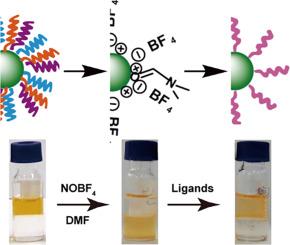A facile and universal ligand exchange strategy enables sequential surface functionalization of quantum dots for high quality in vivo imaging
IF 13.2
1区 工程技术
Q1 ENGINEERING, CHEMICAL
引用次数: 0
Abstract
Fluorescent semiconductor quantum dots (QDs) had the potential to revolutionize biological imaging, but their applications were limited by the difficulties of obtaining biocompatible and high fluorescent-quality QDs due to the difficulty in manipulating surface properties. Here, we explored a facile and effective ligand exchange approach, which enabled sequential surface functionalization and phase transfer of QDs while maintaining QDs fluorescence intensity, size and morphology. Nitrosonium tetrafluoroborate (NOBF4) was employed to substitute for the original organic ligands attached to the QDs surface, stabilizing the QDs in polar and hydrophilic media N,N-dimethylformamide for 60 days without aggregation or precipitation. This method was applicable to a wide range of QDs of different compositions, fluorescence emission wavelengths and sizes. The obtained hydrophilic QDs can subsequently be further functionalized with various capping molecules, which can endow the different surface functionalization of QDs according to the modified molecules employed. Among these, Ag2Te QDs after NOBF4 treatment could undergo sequential surface functionalization, which achieved high-quality in vivo fluorescent imaging. This work offered a versatile ligand exchange strategy for QDs surface functionalization and was a significant step toward controllably engineering the QDs surface properties.

一种简单而通用的配体交换策略使量子点的顺序表面功能化成为高质量的体内成像
荧光半导体量子点(QDs)具有彻底改变生物成像的潜力,但由于难以操纵表面性质,难以获得生物相容性和高荧光质量的量子点,限制了它们的应用。在这里,我们探索了一种简单有效的配体交换方法,在保持量子点荧光强度、大小和形态的同时,实现了量子点的顺序表面功能化和相转移。用四氟硼酸亚硝基取代原有机配体附着在量子点表面,使量子点在极性和亲水介质N,N-二甲基甲酰胺中稳定60 天,无聚集和沉淀。该方法适用于不同组成、荧光发射波长和大小的量子点。所得到的亲水性量子点随后可以用不同的封盖分子进一步功能化,这可以根据所采用的修饰分子赋予量子点不同的表面功能化。其中,NOBF4处理后的Ag2Te量子点可以进行连续的表面功能化,实现高质量的体内荧光成像。这项工作为量子点表面功能化提供了一种通用的配体交换策略,是实现量子点表面特性可控工程的重要一步。
本文章由计算机程序翻译,如有差异,请以英文原文为准。
求助全文
约1分钟内获得全文
求助全文
来源期刊

Chemical Engineering Journal
工程技术-工程:化工
CiteScore
21.70
自引率
9.30%
发文量
6781
审稿时长
2.4 months
期刊介绍:
The Chemical Engineering Journal is an international research journal that invites contributions of original and novel fundamental research. It aims to provide an international platform for presenting original fundamental research, interpretative reviews, and discussions on new developments in chemical engineering. The journal welcomes papers that describe novel theory and its practical application, as well as those that demonstrate the transfer of techniques from other disciplines. It also welcomes reports on carefully conducted experimental work that is soundly interpreted. The main focus of the journal is on original and rigorous research results that have broad significance. The Catalysis section within the Chemical Engineering Journal focuses specifically on Experimental and Theoretical studies in the fields of heterogeneous catalysis, molecular catalysis, and biocatalysis. These studies have industrial impact on various sectors such as chemicals, energy, materials, foods, healthcare, and environmental protection.
 求助内容:
求助内容: 应助结果提醒方式:
应助结果提醒方式:


